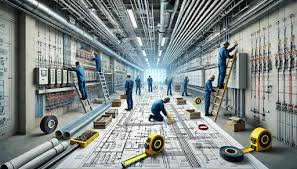Introduction
Cable trays made of FRP (Fiber Reinforced Plastics) are durable and non-metallic support structures. They provide support, routing, and protection for electrical and communications wiring in commercial and industrial environments. Unlike metallic trays, FRP cable trays offer resistance to corrosion, chemicals, and moisture. They perform better in challenging conditions such as chemical plants, offshore installations, and wastewater treatment plants.
FRP cable trays are manufactured using processes like pultrusion or hand lay-up. These methods use fiberglass reinforcement (woven fabric or chopped strands) combined with a resin system such as polyester, vinyl ester, or epoxy. The result is a lightweight, durable composite structure. Manufacturers produce completed and assembled cable trays that are easy to install, require low maintenance, and provide long service life in tough environments.
Manufacturing Process of FRP Cable Trays
Cable trays made of FRP (Fiber Reinforced Plastics) are durable, non-metallic support systems designed for electrical and communication wiring. This continuous process ensures repeatability, high strength, and efficient production. Continuous fiberglass strands pass through a resin bath—polyester, vinyl ester, or epoxy—to ensure complete fiber saturation.
Next, the resin-soaked fibers move through a heated die. Inside the die, they take shape and cure into the required profile such as ladder-type, perforated, or solid-bottom trays. After curing, the trays are cut to size and finished with surface treatment or drilling for mounting. This automated method provides consistency and quality.
The trays produced by pultrusion are lightweight, strong, and resistant to corrosion. They meet strict industrial requirements while remaining easy to handle and install.
Applications and Uses in Different Sectors
FRP Cable Trays India are widely used across industries because of their durability, lightweight design, and non-corrosive properties.
- Chemical and Petrochemical Plants: They withstand acids, solvents, and high moisture levels.
- Electrical Industry: Power plants and substations rely on them for safe cable management because they are nonconductive and heat resistant.
- Marine and Offshore Platforms: They resist saltwater corrosion and handle extreme weather conditions.
- Telecommunications and Data Centers: FRP trays organize sensitive cables without causing electromagnetic interference.
- Water Treatment and Food Processing: Their long life and low maintenance make them suitable for demanding environments.
- Infrastructure Projects: Both indoor and outdoor installations benefit from their reliability and strength.
Conclusion
In conclusion, FRP Cable Trays India provide an excellent alternative to traditional metallic systems. They combine longevity, lightweight design, and corrosion resistance with modern manufacturing techniques like pultrusion. These methods deliver consistent, high-strength products that meet the needs of various industries.
From petrochemicals and power generation to telecom and marine sectors, FRP cable trays have proven their versatility and reliability. As industries demand long-term, low-maintenance solutions, FRP cable trays continue to stand out as one of the best options for modern infrastructure and industrial projects.



